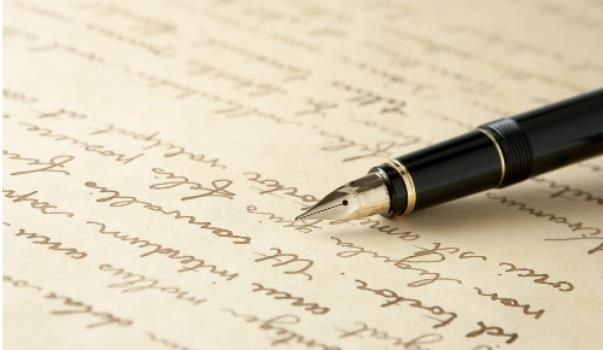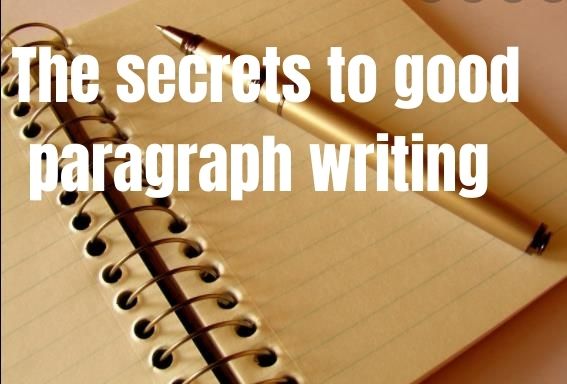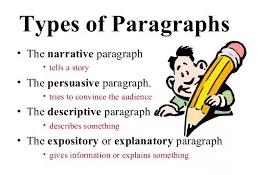A paragraph is a section of writing that covers a single point that explains something specific or argues a specific thing to support the thesis of the whole writing or an essay. This paragraph contains a collection of sentences that argue about the specific item.
You can approach each new paragraph by beginning it on a new line. In some cases, you can construct indented or numbered paragraphs.
Types of Paragraph
There exist different types of paragraphs to help you convey the message as intended originally. Here are the most used ones in the writing career.
In writing, the 5 main types of paragraphs In writing, the 5 main types of paragraphs are descriptive, narrative, persuasive, explanatory, and illustration based on their content and structure. Let us explore each in detail.
1. Descriptive Paragraphs
We use a descriptive paragraph to describe a person, a thing or a theme, or an idea to your audience. We often use this type if you want to provide details about something or an event.
All descriptive phrases utilize five senses such as smells, tastes, feels, looks and sound.

The author becomes clearer to the reader as you use more descriptive phrases.
The correct descriptive paragraph should paint a perfect picture to make the readers as if they were there.
A descriptive paragraph is suitable for fiction writers.
When writing a descriptive paragraph, put the item you are describing in the topic sentence.
In the supporting sentences, provide specific details about the characteristics and functions of that item.
You can also use transitional sentences in the middle, foreground, or far distance.
In the last sentence, you can transition it to the preceding paragraph if it relates to your describing item. Generally, the words should paint a picture in the mind of the audience as indicated in the following section:
There are six horrible men in the vehicle. They want to rescue a naked man. One of them has a pistol to scare the violent naked man.
2. Narrative Paragraphs
The purpose of a narrative paragraph is to tell an event or a story. It could be a natural phenomenon, an account of someone’s life, or a novel.
The author should arrange the events in the narrative paragraph chronologically. That is, they should come in the order of when they happened.
The narrative paragraph should have a central idea and the characters involved. You should provide enough description and set the stage for the reader to understand where they happened.
One should organize such a paragraph into three basic components. They should be a piece of background information, then give the story and end with a conclusion. The topic sentence should include the story or the event and where it happened.
The event can happen in three different stages. They are the beginning, middle, and end of the story. The beginning could be a problem that makes the story.
The middle captures the important activities of the story. The end should serve as the conclusion of the story, as indicated in the following example:
Last week I met John, and we enjoyed a mouth-watering pizza together. After eating, we went to a golf competition where we had fun together.
3. Persuasive Paragraphs
The persuasive paragraph is whereby the writer is offering his opinion on the topic or the subject. The purpose of having such a paragraph is to convince the reader over soothing in the writer’s opinion, like a controversial topic or any project.
The structure of this paragraph follows that of any expository piece, as it helps explain soothing about the subject.
You can sway the reader’s position by employing a rhetorical question. You can use highly charged language to trigger a reaction in the audience.
Such a paragraph should have facts and details to promote the author’s opinion. We can apply such paragraphs in editorial essays or speeches in different forms of writing. The primary goal of such writing is to achieve a reasonable level of persuasion.

We use such occasions to convince the reader to have specific feelings concerning a place or a character. Let’s see the following example.
The best holiday vacation should be on the beach.
Such is so because you can have more fun on the beach.
Such include surfing, swimming or hiking. You can relax as you listen to the ocean wave’s sound and cool breeze.
4. Explanatory Paragraphs
We need an explanation paragraph if you need to describe how a particular thing works. You can sue it if you are explaining a process step by step. Such a paragraph will offer the reader specific details concerning a particular subject.
Such paragraphs contain directions, or you will have to describe that particular process logically. Ensure that such paragraphs provide correct facts to enable the consumer to understand the process well.
You begin by introducing what you are explaining in the topic sentence. Let the supporting sentences explain every step in the whole process. It should include the details of why soothing should happen and provide relevant information.
In this section, you can still use transitional words or phrases. Such could include words like next, eventually, finally, and more.
In the conclusion section, you should offer a summary of the process as indicated in the following example:
The process of making tea is very simple:
- Begin by boiling milk.
- Pour the right amount of water into the milk and let it boil again. After that, add some tea leaves to attain the correct color.
- Remove it from your cooking apparatus and serve while hot.
5. Illustration Paragraphs
Authors use such a paragraph to clarify the idea by giving specific examples. However, you should indicate how they relate to the key points.
The paragraph should follow a specific structure to enable the author to pass the idea to the audience well. One can state the general idea in the topic sentence.
Furthermore, you can use transitional words or phrases to illustrate a particular point. When writing a 5-paragraph essay, for instance, the 3 body paragraphs require such transitional words.
Let the supporting sentences have suitable examples which will amplify the key idea. The role of the examples is to enable the writer to apply a particular point coherently. The conclusion should create a link between the examples and the key idea.
Example
Before you buy land, ensure to involve a real estate agent. The agent can provide resourceful information to help you land a better deal.
Such includes the best and most secure area to buy land and to quote the correct price. Generally, buying land is a slow process that requires keenness.
How to Build a Good Paragraph
A paragraph should provide a structure and the flow of your ideas. Such allows one to move from one thought to the next. The purpose of a paragraph is to adhere to the key idea and paint a clear image.
Whether the author is writing a long or short paragraph, let is follow the basic rule structure. Ensure that the flow of information relates to the preceding paragraphs.
Also, do not make it long. Check our word count tool to help you keep things short. Here are some of the tips to follow when writing a paragraph:
1. Create a Topic Sentence in the First Sentence
The first line of your paragraph should hint at what type of information to expect when reading through the piece.
The first sentences should establish a scenario that sets the audience’s pace in other preceding sentences. In other words, these sentences should begin with a central focus which the remaining part should aim to uphold.
2. Let the Middle Sentences Provide Support
The middle sentence should complement the key sentences in the paragraph or the previous paragraph. You can take advantage of this middle sentence to convince the reader of the key idea you mentioned in the first paragraphs.
Expound every detail concerning the original idea to allow the audience to see everything from your point of view.
3. Let the Final sentence be a transition or conclusion
You can use the last sentences of the paragraph to conclude the idea of that particular paragraph. This ending sentence should provide a summary of the details you provided before moving on to the ideas of the sentences.

Suppose you did not exhaust the information in the previous paragraph, then let this final sentence transition the reader to the next paragraph.
4. Know When to Begin a New Paragraph
When you are starting a new topic, then you need to have a paragraph break. If you are introducing a new idea, then it is vital to use a new paragraph.
The role of paragraph breaks is to set a new stage for other ideas or characters to flow. They are great in generating new moods or feeling for the reader.
In this case, there is no particular amount of sentences for each paragraph. Some instances can have a single sentence paragraph acceptable as long as it compliments your central idea. You must avoid overwhelming your audience with too much information.
5. Use Transition Words
The role of transition words is to tie separate paragraphs together. The transition phrase connects the sentences to form a coherent idea. The reads use such powers to track your ideas by understanding how they relate to one another.
Such words include phrases like “even so,” which makes the idea flow smoothly and gives one a pleasant reading experience. The approach serves bloggers and essay writers who will focus on a single idea as they share it with their audience.


Joseph is a freelance journalist and a part-time writer with a particular interest in the gig economy. He writes about schooling, college life, and changing trends in education. When not writing, Joseph is hiking or playing chess.
